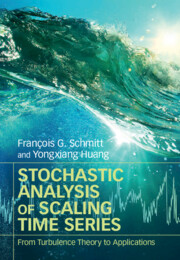Book contents
- Frontmatter
- Contents
- List of figures
- Preface
- 1 Introduction: a multiscale and turbulent-like world
- 2 Homogeneous turbulence and intermittency
- 3 Scaling and intermittent stochastic processes
- 4 New methodologies to deal with nonlinear and scaling time series
- 5 Applications: case studies in turbulence
- 6 Applications: case studies in ocean and atmospheric sciences
- References
- Index
6 - Applications: case studies in ocean and atmospheric sciences
Published online by Cambridge University Press: 05 December 2015
- Frontmatter
- Contents
- List of figures
- Preface
- 1 Introduction: a multiscale and turbulent-like world
- 2 Homogeneous turbulence and intermittency
- 3 Scaling and intermittent stochastic processes
- 4 New methodologies to deal with nonlinear and scaling time series
- 5 Applications: case studies in turbulence
- 6 Applications: case studies in ocean and atmospheric sciences
- References
- Index
Summary
In this chapter, we shall consider several case studies from the ocean and atmospheric sciences. Geophysical fluid dynamics is characterized by important variations over a large range of scales. This is true also of ocean sciences, which are often taken as typical example of complex systems, with a huge number of constitutive elements (fluid particles and their scalar properties) interacting through physical, chemical, and biological relations. In the ocean there has been historically one of the first field validation of Kolmogorov's theory, using data from a channel with strong currents between islands (Grant et al., 1962). Since then, other studies have considered oceanic passive scalars, as well as the fluorescence fluctuations as proxy of phytoplankton concentrations. These have compared fluorescence and temperature using Fourier spectra and correlations (Platt and Denman, 1975; Denman, 1976; Denman et al., 1977) and using multifractal approaches (Seuront et al., 1996a,b, 1999). Multifractal studies in the field of oceanology have also been done also using satellite images (Tessier et al., 1993; Lovejoy et al., 2001a,b; Nieves et al., 2007; Pottier et al., 2008; Turiel et al., 2009; de Karman et al., 2011; Renosh et al., 2015).
Superposed to the stochastic variability related to turbulence, coastal marine fields are also subject to deterministic periodic forcing, at fixed scales, such as tidal, diurnal, and annual forcing scales. Hence, time series in the marine sciences can be quite complex and their analysis nontrivial. In the present chapter, we focus on several coastal time series. We first present a coastal marine turbulence time series recorded at 1 Hz in a megatidal sea. We then present a long-term series of water level dynamics recorded every hour, and a database of water quality automatic monitoring recorded at fixed point every 20 minutes, with emphasis on three quantities: temperature, dissolved oxygen, and fluorescence. We finally consider atmospheric examples: atmospheric wind velocity and wind power time series. In each case we perform power spectra, identify some scaling ranges and forcing, and apply several methods among the methods described in the methodological chapters.
Coastal marine turbulence
We first consider coastal marine turbulence, the interface between land and sea. Close to the shore, waves break and provide a surplus of energy to the marine system. The zone where the bottom has influence on waves is the surf zone (Svendsen, 1987; Battjes, 1988; Schmitt et al., 2009).
- Type
- Chapter
- Information
- Stochastic Analysis of Scaling Time SeriesFrom Turbulence Theory to Applications, pp. 162 - 184Publisher: Cambridge University PressPrint publication year: 2016



